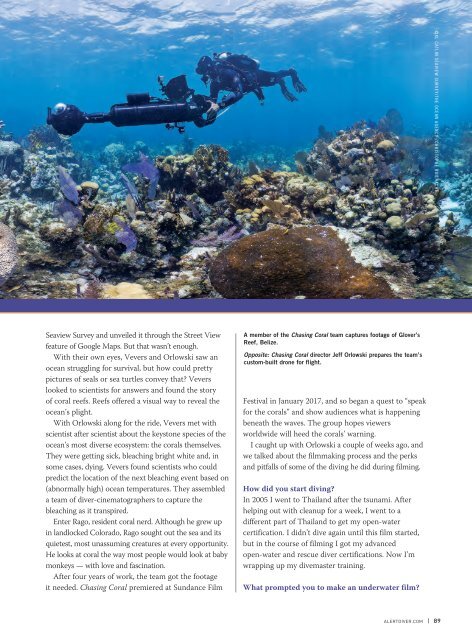AD 2017 Q4
Alert Diver is the dive industry’s leading publication. Featuring DAN’s core content of dive safety, research, education and medical information, each issue is a must-read reference, archived and shared by passionate scuba enthusiasts. In addition, Alert Diver showcases fascinating dive destinations and marine environmental topics through images from the world’s greatest underwater photographers and stories from the most experienced and eloquent dive journalists in the business.
Alert Diver is the dive industry’s leading publication. Featuring DAN’s core content of dive safety, research, education and medical information, each issue is a must-read reference, archived and shared by passionate scuba enthusiasts. In addition, Alert Diver showcases fascinating dive destinations and marine environmental topics through images from the world’s greatest underwater photographers and stories from the most experienced and eloquent dive journalists in the business.
Create successful ePaper yourself
Turn your PDF publications into a flip-book with our unique Google optimized e-Paper software.
©XL CATLIN SEAVIEW SURVEY/THE OCEAN AGENCY /CHRISTOPHE BAILHACHE<br />
Seaview Survey and unveiled it through the Street View<br />
feature of Google Maps. But that wasn’t enough.<br />
With their own eyes, Vevers and Orlowski saw an<br />
ocean struggling for survival, but how could pretty<br />
pictures of seals or sea turtles convey that? Vevers<br />
looked to scientists for answers and found the story<br />
of coral reefs. Reefs offered a visual way to reveal the<br />
ocean’s plight.<br />
With Orlowski along for the ride, Vevers met with<br />
scientist after scientist about the keystone species of the<br />
ocean’s most diverse ecosystem: the corals themselves.<br />
They were getting sick, bleaching bright white and, in<br />
some cases, dying. Vevers found scientists who could<br />
predict the location of the next bleaching event based on<br />
(abnormally high) ocean temperatures. They assembled<br />
a team of diver-cinematographers to capture the<br />
bleaching as it transpired.<br />
Enter Rago, resident coral nerd. Although he grew up<br />
in landlocked Colorado, Rago sought out the sea and its<br />
quietest, most unassuming creatures at every opportunity.<br />
He looks at coral the way most people would look at baby<br />
monkeys — with love and fascination.<br />
After four years of work, the team got the footage<br />
it needed. Chasing Coral premiered at Sundance Film<br />
A member of the Chasing Coral team captures footage of Glover’s<br />
Reef, Belize.<br />
Opposite: Chasing Coral director Jeff Orlowski prepares the team’s<br />
custom-built drone for flight.<br />
Festival in January <strong>2017</strong>, and so began a quest to “speak<br />
for the corals” and show audiences what is happening<br />
beneath the waves. The group hopes viewers<br />
worldwide will heed the corals’ warning.<br />
I caught up with Orlowski a couple of weeks ago, and<br />
we talked about the filmmaking process and the perks<br />
and pitfalls of some of the diving he did during filming.<br />
How did you start diving?<br />
In 2005 I went to Thailand after the tsunami. After<br />
helping out with cleanup for a week, I went to a<br />
different part of Thailand to get my open-water<br />
certification. I didn’t dive again until this film started,<br />
but in the course of filming I got my advanced<br />
open-water and rescue diver certifications. Now I’m<br />
wrapping up my divemaster training.<br />
What prompted you to make an underwater film?<br />
ALERTDIVER.COM | 89









